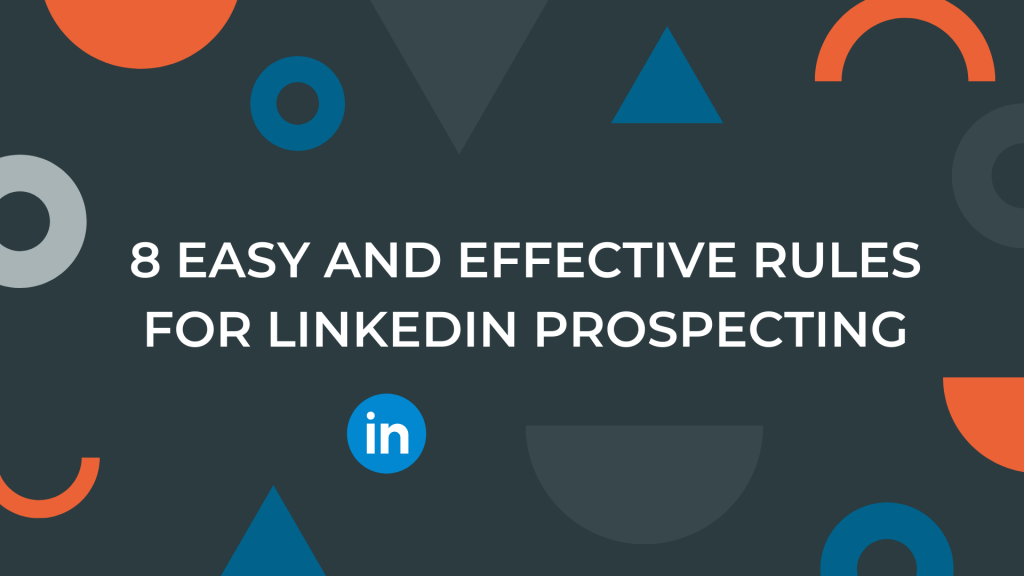
Sales prospecting is one of the most important parts of the whole sales process.
Many salespeople admit that they find it difficult to get new prospects.
To be more precise, 34% of them say prospecting and lead qualification are salespeople’s top challenges.
But, before you wave the white flag and resort to purchasing a list on the internet (which is the worst thing you can do), you should try different strategies.
LinkedIn, for example, offers a plethora of tactics that you can use to identify and attract high-quality prospects.
At first sight, these strategies seem like a piece of cake and even trivial, but don’t let this perceived simplicity mislead you.
If you invest your time and energy, the results of your LinkedIn prospecting will follow.
No Missing Links
740 million is the number of currently registered users on LinkedIn.
That’s a seriously huge database of various business professionals that you can get in touch with if you start using this network properly. This means more than just creating a profile and browsing through your feed occasionally.
Your LinkedIn should be your second office!
The fact that executives from every single Fortune 500 company are on LinkedIn means that:
A) it’s pretty darn useful
B) you can actually get in touch with some of them (Hey there, Elon. How’s SpaceX going?)
But most importantly, by following these successful guys and gals on this network, you’ll be able to find out more about their daily routine, get an insight into their way of thinking, and see what they like, share and comment on.
Memes, gifs, jokes, and various internet rants can be funny, but why wasting your time reading useless posts on other social media websites, when you can spend your time constructively and learn something new?
There are numerous methods of expanding your reach and growing your network on LinkedIn.
Shawn Finder, Sales GM at Autoklose – a VanillaSoft Brand, discussed some of them in his webinar on 7 Tips for Using LinkedIn for Lead Gen.
We partnered up with SMM who recorded this session so that you can listen to it at any time: 
We also decided to elaborate on the topic and present you with some useful guidelines on how to make the most of LinkedIn for prospecting.
1. Show’em What You Got!
Defining the purpose of your business should be your first step.
What’s your unique selling point?
What are your skills?
What can you offer?
What can you deliver?
Think about what sets you apart from your competitors.
List your existing and former clients and try to figure out how you help their respective businesses. You can and should be very specific about this.
Just don’t get carried away and try to be everything to everybody. Don’t dilute the essence of your skills.
Focus only on prospects to whom you can offer the best solutions.
The average doesn’t work in business.
Of course, this will reduce the pool of your potential prospects, but you can be sure that you’ll turn heads of high-quality prospects, that is those who are the perfect fit for your business.
Check out how Darryl Praill, CRO at VanillaSoft, presented himself, his strong points, expertise, and experience:
2. Who’s the Client of Your Dreams
Think about the profile of people you see as your clients.
Here’s what you should establish:
- Who are the people who could greatly benefit from your skills and the solutions your company provides?
- What kind of clients do you enjoy working with? Don’t forget that your job has to bring you satisfaction and joy.
- Marketing personas. This approach will help you get a comprehensive picture of your ideal prospects. Think about their job titles, industries, types of business, locations, and other parameters that are important to you.
This will give you a clear idea as to how to perform your search and how to target your prospects.
3. Polish and Tweak Your Profile
If you want to use LinkedIn as a sales tool, profile optimization is crucial for the success of this whole endeavor.
Remember that you need to differentiate yourself among these 740 million business professionals.
Besides, lead generation is a two-way street – you’re not the only one who will do the search, so make sure to polish your profile and help your potential leads find you.
Your profile is your virtual business card and you need to put your best foot forward if you want to attract the best opportunities.
Here’s how:
- Include a professional headshot. This will significantly improve the visibility of your profile, as surveys say that you’ll get 14 times more views, 9 times more connections, and 36 times more messages. So, strike a pose and you might strike it lucky.
- Upload a visually appealing, custom background photo. Keep it simple and align it with the style and design of your profile photo.
- Craft a descriptive but still concise job title, and make sure to include a relevant keyword in order to make sure that you’ll appear among the top search results in Google.
- Write a summary that will accentuate all your strong points and skills, and mention some of your most important achievements. Also, don’t forget to add a keyword for SEO purposes. Just don’t overdo it in order to avoid being spammy.
- Add detailed portfolio content that will show what you can do for your clients. Highlight how your expertise can bring value to your prospects. Leverage social proof and mention some of your happy clients (with their approval, of course).
Here’s how Vedran Rasic, Director of Marketing at VanillaSoft, composed his summary and covered all the bases:
4. The Company You Keep
After you’ve completed optimizing your profile, it’s time to start spinning your professional web.
It’s essential to connect with as many people as possible because that way you’ll appear in more searches and improve the visibility of your profile.
Since your name will appear only in the search results for people in your network, that is, 1sr, 2nd, and 3rd-level connections and groups you’re a member of, it’s important to expand your network beyond the connections you personally know.
Since most of your connection attempts will practically be cold outreach, it’s a good idea to make the most of your business acquaintances.
Namely, when you meet somebody new at a conference or a similar event, send them a connection request as soon as possible, while you’re still fresh in their memory.
The same applies even when it comes to people who aren’t your potential clients. This will help you expand your network as well as your reach.

5. Connect Strategically
After you’ve connected with people you know and work with IRL, it’s time to tread the uncharted waters and send requests to people you have never met before.
But how do you do that?
Luckily, LinkedIn isn’t Facebook where sending a friend request to a stranger makes you a weird stalker.
Quite the opposite, it’s more than recommended to visit as many profiles and click that “connect” button.
But, there’s no need to do this randomly, when you can have a strategic plan.
- The “People Also Viewed” sidebar on the right is an excellent starting point. Check out some of your most valuable clients or people you’d like to be your clients, and this cool widget will show you similar contacts. And just like that, you’ve unearthed new opportunities.
- Join groups relevant to your industry or interests. This is a great way of connecting with numerous professionals from your niche and getting in touch (and possibly interacting) with potential clients. The trick is to participate in various discussions and establish yourself as an expert in your field. That’s a surefire way to be noticed.
- Spy on your competitors and browse through their network. The odds are that their clients would be interested in your products too, so why not give it a shot?
- Check out skill endorsements. This is similar to the “people also viewed” tactic – browse through your existing prospects’ skill endorsements and identify the people who endorsed them. Very frequently those will be their business partners, colleagues, and people who share similar interests. And you’ve got yourself a true gold mine of prospect information.
- People who viewed your profile. This one is fairly easy. View them back and send them a connection request.
- People who commented on your prospects’ posts. Being a stalker actually pays off on LinkedIn, so don’t hesitate to investigate people who interacted with your prospects. Check them out and see if they might be interested in your products or services.
- Look for people belonging to a similar niche. It’s important to connect with professionals whose target market is similar, but who don’t offer the same products or services. The complementary nature of your relationship could give both your and their prospecting efforts a boost.
- Ask your existing connection for an introduction. This is a great prospecting tactic because you’ll be previously announced by a shared connection. Needless to say, this kind of introduction eliminates the “cold” from your outreach.
- Ask for a referral. Dropping names can do wonders when it comes to prospecting. Just make sure that you’ve asked the person in question for their approval to mention them. Such an approach carries a bit more weight than a regular connection request.
But, it’s worth mentioning that it’s not a good idea to send a connection request without a message, so make sure to carefully craft it and avoid being perceived as too pushy.
There are various ways to break the ice and start a conversation, and it’s crucial to learn more about your prospects and try to establish rapport and some common ground.
6. Get Up Close and Personal
It can’t be stressed enough how personalization is important for any kind of outreach, and especially on LinkedIn.
Using generic copy is lame and lazy, so go the extra mile and make your prospects feel special.
Learn as much about your prospect, and don’t be afraid to offer your opinion on their latest blog post or status update.
The ice breaker could be your saying that you find their latest article particularly useful.
Praising their business achievements is also a good way to start effective outreach. Your prospects are only human and who doesn’t like a little ego boost?
Just make sure that you’re sincere and that what you say makes sense.
Here’s an example:
| Hello Peter, I just wanted to congratulate you on your new position. You’ll make a great CMO. I’ve had an opportunity to see what you did as a Growth Manager of XYZ, so it would be great if you could share a couple of tips with me. Being in the same niche, I’d like to give your approach a try and boost my traffic and visibility. Best Shawn |
By tailoring your message you’re not only increasing the probability that your prospect will accept your request, but you also improve the chances that it will develop into a meaningful conversation.
And you know that in sales, and business in general, everything revolves around a good, honest-to-goodness, no-nonsense talk.
However, many people want to make as much of LinkedIn prospecting, so they tend to use third-party automation tools in order to streamline the LinkedIn connecting and messaging process. A good example is organizing and tagging Linkedin contacts. This approach undoubtedly frees up a lot of their time and allows them to focus on building actual relationships with their prospects.
But, before you decide to automate your LinkedIn outreach, it’s a good idea to learn more about the benefits and dangers of the process.
7. Use LinkedIn Sales Navigator
LinkedIn Sales Navigator is one of the premium LinkedIn membership levels. This paid tool lets you generate and export leads more efficiently and effectively. As it’s tailored to salespeople’s needs, Sales Navigator boasts superb targeting options, meaning that you can:
- Narrow down your search
- Leverage very specific filters including leads with recent job changes, group memberships, or posted content keywords
- View leads similar to your existing target audience and particular clients
All these and many more features of this powerful tool will allow you to personalize your approach, engage your leads, and build meaningful connections using valuable insights you get from Sales Navigator.
Another way to take advantage of this lead generation tool is to click on the Discover tab. Based on your sales preferences, profile interactions, and search history, Sales Navigator will show you personalized lead recommendations.
With Sales Navigator InMail, you can directly message prospects you’re not connected to, which isn’t possible if you have a Basic, free account.
Sales Navigator provides you with meaningful insights, such as your prospects’ experience and interests as well as their profile information, within the compose window, so that you can personalize your outreach and reference their professional achievements while creating your message.
You can send an InMail message from your prospect’s profile page, Sales Navigator search results, or search results in your Navigator inbox.
8. Engage!
All the above-mentioned tactics won’t come to fruition unless you go out there and have your say.
There are different ways of interacting with your connections.
Luckily, there are also numerous occasions that you can use as a perfectly good reason to do so.
- Congratulate your contacts on their new job or title. There are also birthdays, job anniversaries, and different professional achievements that you can mention.
- When your contact is tagged in a post, or they’re mentioned in an article, don’t miss out on the opportunity to acknowledge that.
- Share useful blog posts, articles, reports, and other resources that your prospects might find helpful. Sharing is caring, right? Besides, it doesn’t require too much time.
- Comment on their updates and posts. This will keep you on their radar and get them to interact with you personally. However, it’s important that your comments are meaningful and valuable. The worst mistake is doing that just for the sake of it. “I agree” or “You nailed it” for example, don’t provide any particular value to your connection, not to mention that they don’t add to the whole discussion. Try to spark conversation and offer your unique perspective on things.
- Monitor your prospects’ activity on LinkedIn as that will allow you to plan your follow-ups and build loyalty.
- Offer help. Instead of asking for a favor first, tell your prospects how you can help them. This doesn’t mean that you should push your offer and ask them to try your product. Sometimes your pro bono efforts might land you a better deal than the ones with a price tag.
Shawn Finder once posted an interesting update in which he provided a couple of his ideas on what differentiates great salespeople from the average ones.
He also encouraged the community to provide their responses.
The result was a lively discussion full of interesting and practical advice.
But that’s not all.
We used their feedback to create a blog post and shared it across all our social media channels, including LinkedIn.
But since we didn’t want to take credit for their great ideas, we additionally engaged them by tagging every single person who contributed to this great conversation.
A subsequent update generated a lot of engagement too.
Now, that’s a real, two-way conversation that brought real value both to our LinkedIn network, all visitors to our website, as well as to us.
In other words, following up should be a central part of your prospecting strategy.
We also have a pretty detailed blog post on getting your follow-up right.
LinkedIn is every businessperson’s most valuable prospecting resource, and the time you spend branching out your network and building relationships is one of the best investments that you can make.
These lead generation methods work best when they’re paired with Autoklose’s reliable sales automation platform that comes with a huge and constantly updated database brimming with clean, verified, and relevant B2B leads from different industries.
Give it a try and let us know about your results. We’re sure they will be awesome.

 The Autoklose
The Autoklose 


[…] We already discussed prospecting on LinkedIn in one of our previous blog posts and explained the bes…. […]